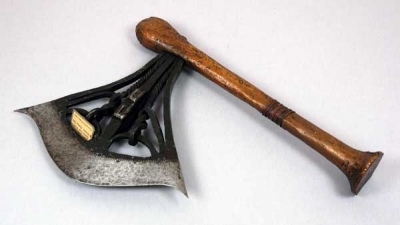Axe (1907.21.28)
 CongoAxe from the Democratic Republic of Congo, Africa. Collected by Emil Torday between 1905 and 1906. Given to the Museum in 1907.
CongoAxe from the Democratic Republic of Congo, Africa. Collected by Emil Torday between 1905 and 1906. Given to the Museum in 1907.
Ornamental axe from the Kasai district of DR Congo. The iron blade has been formed into five bars, two of which have been twisted and the central one bearing four human faces in relief. The handle has been covered in copper.
Warrior Elites
The Nsapo are one of 35 cultural subgroups of the Songye, spread across the south-eastern Congo basin. Axes (kilonda) were made throughout the Songye area. They were never used as functional weapons or tools but instead served as the insignia of high chiefly rank, and indicated that their bearer possessed the status of Sultani (local chief). They were also the insignia of diviners. The human figures wrought artistically into these blades are believed to depict cultural groups who are subordinate to the Sultani.
Axes are important symbols of power and kingship in many parts of Central and West Africa. They embody the ruler's ability to manifest his intentions and to speak with words that bite or cut. Among the Luba, neighbours of the Songye, ornate axes performed almost exactly the same function. However, the focus of their artistic manufacture was reversed, exhibiting simple blades and carved wooden handles of great complexity. The kings of Benin traditionally carried ancient stone axes, which symbolised Ogiwu, the god of death, disease and lightning. Among the Fulani of northern Cameroon, axes are carried by men who have been through a male initiation rite. These Fulani axes possess human elements like this Nsapo example, and express the manhood and handsomeness of the initiate. Among several Congolese peoples, including the Songye, Luba and BaKongo, minkishi or 'power figures' often had the blades of axes hammered into them to cause similar wounds to an enemy, showing that iron blades were understood to possess spiritual power.
Overall we can see that, in much of Africa, the axe symbolises the ruler's effectiveness, much as the sword has done in Europe for centuries.





